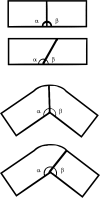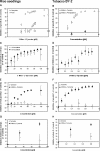Plant cell division is specifically affected by nitrotyrosine
- PMID: 20018903
- PMCID: PMC2814120
- DOI: 10.1093/jxb/erp369
Plant cell division is specifically affected by nitrotyrosine
Abstract
Virtually all eukaryotic alpha-tubulins harbour a C-terminal tyrosine that can be reversibly removed and religated, catalysed by a specific tubulin-tyrosine carboxypeptidase (TTC) and a specific tubulin-tyrosine ligase (TTL), respectively. The biological function of this post-translational modification has remained enigmatic. 3-nitro-L-tyrosine (nitrotyrosine, NO(2)Tyr), can be incorporated into detyrosinated alpha-tubulin instead of tyrosine, producing irreversibly nitrotyrosinated alpha-tubulin. To gain insight into the possible function of detyrosination, the effect of NO(2)Tyr has been assessed in two plant model organisms (rice and tobacco). NO(2)Tyr causes a specific, sensitive, and dose-dependent inhibition of cell division that becomes detectable from 1 h after treatment and which is not observed with non-nitrosylated tyrosine. These effects are most pronounced in cycling tobacco BY-2 cells, where the inhibition of cell division is accompanied by a stimulation of cell length, and a misorientation of cross walls. NO(2)Tyr reduces the abundance of the detyrosinated form of alpha-tubulin whereas the tyrosinated alpha-tubulin is not affected. These findings are discussed with respect to a model where NO(2)Tyr is accepted as substrate by TTL and subsequently blocks TTC activity. The irreversibly tyrosinated alpha-tubulin impairs microtubular functions that are relevant to cell division in general, and cell wall deposition in particular.
Figures





Comment in
-
Assembly and disassembly of plant microtubules: tubulin modifications and binding to MAPs.J Exp Bot. 2010 Mar;61(3):623-6. doi: 10.1093/jxb/erp395. Epub 2010 Jan 15. J Exp Bot. 2010. PMID: 20080825 No abstract available.
Similar articles
-
Suppression of tubulin detyrosination by parthenolide recruits the plant-specific kinesin KCH to cortical microtubules.J Exp Bot. 2015 Apr;66(7):2001-11. doi: 10.1093/jxb/erv012. Epub 2015 Mar 16. J Exp Bot. 2015. PMID: 25779700 Free PMC article.
-
Incorporation of 3-nitrotyrosine into the C-terminus of alpha-tubulin is reversible and not detrimental to dividing cells.Eur J Biochem. 2002 Oct;269(20):5037-45. doi: 10.1046/j.1432-1033.2002.03220.x. Eur J Biochem. 2002. PMID: 12383263
-
A rice tubulin tyrosine ligase-like 12 protein affects the dynamic and orientation of microtubules.J Integr Plant Biol. 2021 May;63(5):848-864. doi: 10.1111/jipb.13059. Epub 2021 Mar 19. J Integr Plant Biol. 2021. PMID: 33336892
-
Production and utilization of detyrosinated tubulin in developing Artemia larvae: evidence for a tubulin-reactive carboxypeptidase.Biochem Cell Biol. 1995 Sep-Oct;73(9-10):673-85. doi: 10.1139/o95-075. Biochem Cell Biol. 1995. PMID: 8714688 Review.
-
The detyrosination/re-tyrosination cycle of tubulin and its role and dysfunction in neurons and cardiomyocytes.Semin Cell Dev Biol. 2023 Mar 15;137:46-62. doi: 10.1016/j.semcdb.2021.12.006. Epub 2021 Dec 17. Semin Cell Dev Biol. 2023. PMID: 34924330 Review.
Cited by
-
Insights into the Mechanisms of Heat Priming and Thermotolerance in Tobacco Pollen.Int J Mol Sci. 2021 Aug 8;22(16):8535. doi: 10.3390/ijms22168535. Int J Mol Sci. 2021. PMID: 34445241 Free PMC article.
-
Flax tubulin and CesA superfamilies represent attractive and challenging targets for a variety of genome- and base-editing applications.Funct Integr Genomics. 2020 Jan;20(1):163-176. doi: 10.1007/s10142-019-00667-2. Epub 2019 Mar 2. Funct Integr Genomics. 2020. PMID: 30826923 Review.
-
A rice class-XIV kinesin enters the nucleus in response to cold.Sci Rep. 2018 Feb 26;8(1):3588. doi: 10.1038/s41598-018-21816-w. Sci Rep. 2018. PMID: 29483672 Free PMC article.
-
Suppression of tubulin detyrosination by parthenolide recruits the plant-specific kinesin KCH to cortical microtubules.J Exp Bot. 2015 Apr;66(7):2001-11. doi: 10.1093/jxb/erv012. Epub 2015 Mar 16. J Exp Bot. 2015. PMID: 25779700 Free PMC article.
-
Salt-inducible expression of OsJAZ8 improves resilience against salt-stress.BMC Plant Biol. 2018 Nov 29;18(1):311. doi: 10.1186/s12870-018-1521-0. BMC Plant Biol. 2018. PMID: 30497415 Free PMC article.
References
-
- Barra HS, Rodriguez JA, Arce CA, Caputto R. A soluble preparation from rat brain that incorporates into its own proteins [14C]arginine by a ribonuclease-sensitive system and [14C]tyrosine by a ribonuclease-insensitive system. Journal of Neurochemistry. 1973;20:97–108. - PubMed
-
- Beckman JS, Koppenol WH. Nitric oxide, superoxide, and peroxynitrite: the good, the bad, and the ugly. American Journal of Physiology. 1996;271:1424–1437. - PubMed
-
- Bensadoun A, Weinstein D. Assay of proteins in the presence of interfering materials. Analytical Biochemistry. 1976;70:241–250. - PubMed
-
- Bisig CG, Purro SA, Contin MA, Barra HS, Arce CA. Incorporation of 3-nitrotyrosine into the C-terminus of α-tubulin is reversible and not detrimental to dividing cells. European Journal of Biochemistry. 2002;269:5037–5045. - PubMed
-
- Breitling F, Little M. Carboxy-terminal regions on the surface of tubulin and microtubules. Epitope locations of YOL1/34, DM1A and DM1B. Journal of Molecular Biology. 1986;189:367–370. - PubMed

